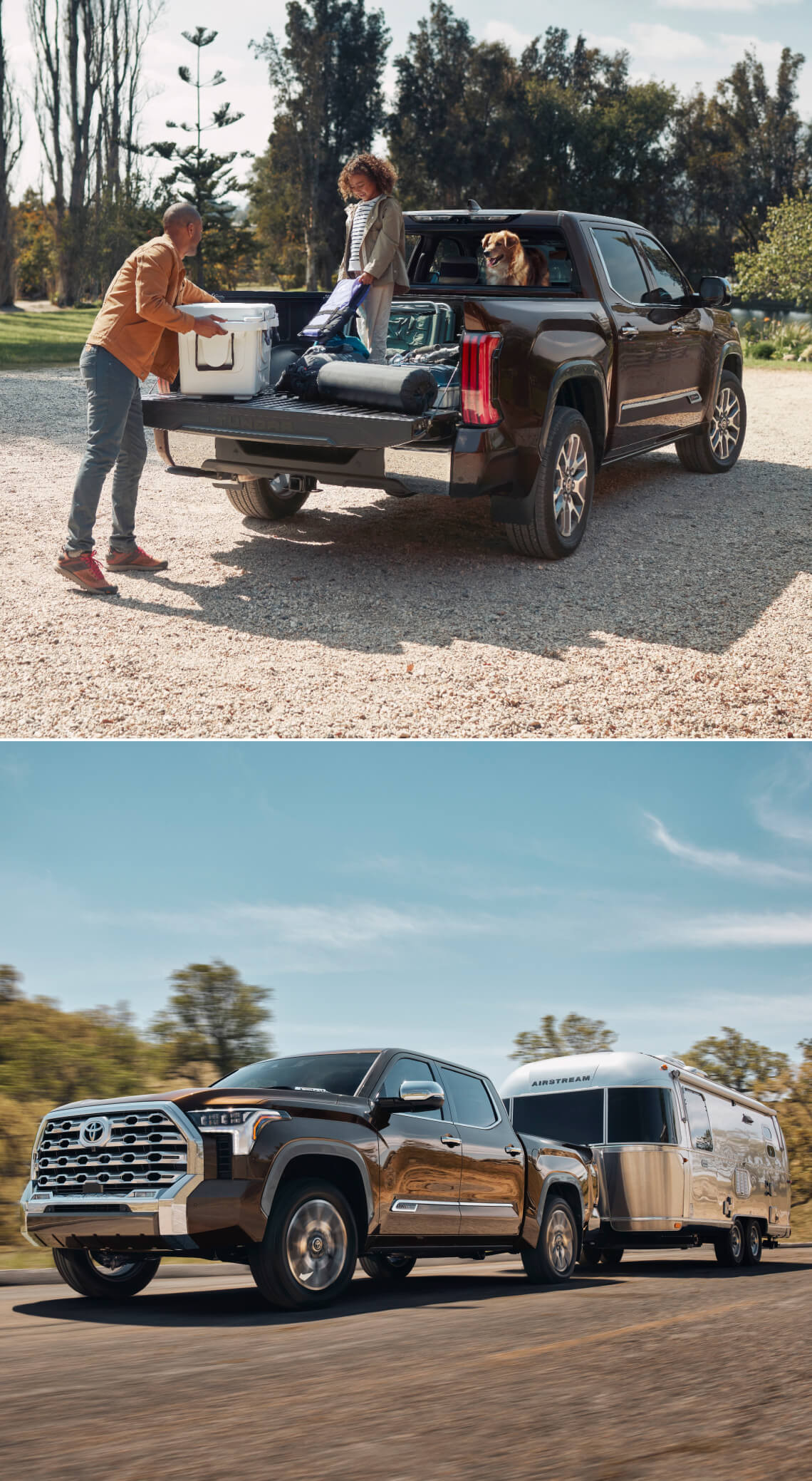How Much Can A Toyota Tundra Haul In The Bed? The Toyota Tundra offers impressive hauling capabilities, and at millertoyota.net, we understand the importance of knowing exactly what your truck can handle; with the proper configuration, a 2025 Tundra can haul up to 1,940 pounds in its bed. Discover the perfect Tundra for your needs, explore our extensive inventory, and experience exceptional service at Miller Toyota in Boise.
1. What Determines the Toyota Tundra’s Bed Hauling Capacity?
The Toyota Tundra’s bed hauling capacity, also known as payload capacity, hinges on several key factors. Understanding these elements is crucial for maximizing your truck’s utility while ensuring safety and preventing damage.
-
Configuration: The Tundra’s cab style (Double Cab or CrewMax) and bed length (5.5-foot, 6.5-foot, or 8.1-foot) significantly impact payload capacity.
-
Trim Level: Different trims, such as SR, SR5, Limited, Platinum, 1794 Edition, TRD Pro, and Capstone, offer varying payload capabilities due to differences in standard equipment and features.
-
Engine: The engine type, whether it’s the i-FORCE 3.4L Twin-Turbo V6 or the i-FORCE MAX 3.4L Twin-Turbo V6 Hybrid, affects the overall weight and therefore the payload capacity.
-
Drivetrain: Rear-Wheel Drive (RWD) and Four-Wheel Drive (4WD) configurations have different weights, influencing the amount of weight the truck can safely carry in the bed.
-
Options and Accessories: Additional features and accessories, such as bed liners, tonneau covers, and aftermarket equipment, add weight and reduce the available payload capacity.
According to Toyota, proper weight distribution is also key to achieving maximum payload. Overloading the truck or unevenly distributing weight can lead to safety hazards, reduced handling, and potential damage to the vehicle.
2. What Is the Maximum Bed Hauling Capacity of the Latest Toyota Tundra?
The maximum bed hauling capacity for the latest Toyota Tundra, specifically the 2025 model, is 1,940 pounds. This peak payload capacity is achievable with specific configurations, primarily the Tundra SR Double Cab and Tundra SR5 Double Cab models. These models are equipped with the i-FORCE 3.4-liter Twin-Turbo V6 engine, paired with RWD and a 6.5-foot bed. It’s important to note that opting for different trims, cab styles, bed lengths, or drivetrains will result in varying payload capacities.
Here is a general range of payload capacities based on trim level:
- SR: Up to 1,940 pounds
- SR5: Up to 1,940 pounds
- Limited: Slightly lower due to added features
- Platinum: Further reduced due to luxury appointments
- 1794 Edition: Similar to Platinum
- TRD Pro: Designed for off-road performance, may have a lower payload
- Capstone: Top-tier luxury trim, typically with the lowest payload
 Toyota Tundra Bed
Toyota Tundra Bed
3. How Does the Toyota Tundra’s Bed Size Impact Hauling Capacity?
The bed size of the Toyota Tundra significantly impacts its hauling capacity. The Tundra offers three bed lengths: 5.5-foot (Short Bed), 6.5-foot (Standard Bed), and 8.1-foot (Long Bed).
-
5.5-foot Short Bed: Typically found on CrewMax models, this bed size prioritizes passenger space. While convenient, it offers the lowest payload capacity due to the truck’s overall configuration.
-
6.5-foot Standard Bed: Available on both Double Cab and CrewMax models, this bed length strikes a balance between cargo space and passenger comfort. It generally offers a higher payload capacity than the 5.5-foot bed.
-
8.1-foot Long Bed: Exclusively available on Double Cab models, this bed length provides the maximum cargo space and is ideal for those who frequently haul large items. It typically offers the highest payload capacity.
Longer beds can distribute weight more evenly, contributing to increased stability and safer hauling.
According to a study by the Society of Automotive Engineers (SAE), proper load distribution is critical, and longer beds provide more flexibility in achieving this.
4. What Is the Towing Capacity vs. Bed Hauling Capacity in a Toyota Tundra?
Towing capacity and bed hauling capacity (payload) are two distinct but equally important measures of a truck’s capability. It’s crucial to understand the difference to ensure safe and effective use of your Toyota Tundra.
-
Towing Capacity: Refers to the maximum weight a truck can pull behind it, typically with a trailer. This is influenced by factors like engine power, transmission, axle ratio, and the truck’s overall structure. The 2025 Toyota Tundra boasts a maximum towing capacity of 12,000 pounds when properly equipped.
-
Bed Hauling Capacity (Payload): Refers to the maximum weight a truck can carry in its bed, including passengers, cargo, and any aftermarket accessories. This is limited by the truck’s suspension, frame, and Gross Vehicle Weight Rating (GVWR). The 2025 Toyota Tundra has a maximum payload capacity of 1,940 pounds in specific configurations.
Towing involves pulling weight, while payload involves carrying weight. Exceeding either limit can lead to:
- Safety Risks: Reduced braking performance, impaired handling, and increased risk of accidents.
- Mechanical Damage: Overstressing the engine, transmission, suspension, and frame.
- Legal Issues: Potential fines and liability in case of an accident.
According to the National Highway Traffic Safety Administration (NHTSA), understanding and adhering to both towing and payload capacities is essential for safe vehicle operation.
5. How Do Different Toyota Tundra Trims Affect Bed Hauling Capacity?
Different Toyota Tundra trims offer varying bed hauling capacities due to differences in standard equipment, features, and overall vehicle weight. Here’s a general overview of how each trim level affects payload:
-
SR: The base model typically offers the highest payload capacity as it has fewer standard features, resulting in a lighter overall weight.
-
SR5: While offering more features than the SR, the SR5 still maintains a competitive payload capacity, making it a popular choice for those needing a balance of utility and comfort.
-
Limited: This trim adds more luxury features, increasing the vehicle’s weight and slightly reducing the payload capacity compared to the SR and SR5.
-
Platinum: With even more premium features and materials, the Platinum trim typically has a lower payload capacity than the SR, SR5, and Limited.
-
1794 Edition: Similar to the Platinum, the 1794 Edition offers a luxurious interior and advanced features, resulting in a reduced payload capacity.
-
TRD Pro: Designed for off-road performance, the TRD Pro includes specialized suspension and other off-road equipment, which can affect the payload capacity.
-
Capstone: As the top-tier luxury trim, the Capstone features the most opulent amenities, leading to the lowest payload capacity among the Tundra trims.
For instance, the SR Double Cab with a 6.5-foot bed is geared towards maximizing payload, while the Platinum CrewMax is designed for comfort and features, which impacts its hauling capability.
6. What Engine Options Are Available, and How Do They Affect Bed Hauling Capacity?
The Toyota Tundra offers two primary engine options, each influencing the truck’s bed hauling capacity:
-
i-FORCE 3.4L Twin-Turbo V6: This engine is standard on most Tundra trims and provides a balance of power and efficiency. It delivers up to 389 horsepower and 479 lb-ft of torque, depending on the configuration.
-
i-FORCE MAX 3.4L Twin-Turbo V6 Hybrid: This hybrid powertrain combines the V6 engine with an electric motor, producing an impressive 437 horsepower and 583 lb-ft of torque. It’s available on select trims like the Limited, Platinum, 1794 Edition, TRD Pro, and Capstone.
The i-FORCE MAX engine provides more power and torque but also adds weight due to the hybrid components. This additional weight can slightly reduce the maximum payload capacity compared to models equipped with the standard i-FORCE V6 engine.
According to testing performed by Edmunds, trucks with more powerful engines don’t always equate to higher payload capacities due to the added weight of the larger engine and related components.
7. How Does the Drivetrain (RWD vs. 4WD) Influence Bed Hauling Capacity?
The drivetrain of a Toyota Tundra, whether it’s Rear-Wheel Drive (RWD) or Four-Wheel Drive (4WD), has a notable impact on its bed hauling capacity.
-
Rear-Wheel Drive (RWD): RWD Tundras are generally lighter than their 4WD counterparts. This weight difference allows for a higher payload capacity, as the truck can carry more weight in the bed without exceeding its Gross Vehicle Weight Rating (GVWR).
-
Four-Wheel Drive (4WD): 4WD Tundras have additional components, such as a transfer case, front differential, and extra driveshaft, which add weight to the vehicle. This increased weight reduces the available payload capacity.
For example, the SR5 Double Cab RWD with a 6.5-foot bed can achieve the maximum payload capacity, while the same trim with 4WD will have a slightly lower capacity due to the added weight of the 4WD system.
According to data from Toyota, the weight difference between RWD and 4WD configurations can range from 200 to 300 pounds, directly affecting the payload capacity.
8. What Features Can Enhance the Toyota Tundra’s Bed Hauling Experience?
The Toyota Tundra offers several features that can enhance the bed hauling experience, making it safer, more convenient, and more efficient.
-
Bedliner: Protects the truck bed from scratches, dents, and corrosion, extending its lifespan. Options include spray-in bedliners and drop-in bedliners.
-
Tonneau Cover: Secures cargo, protects it from the elements, and can improve fuel efficiency by reducing aerodynamic drag. Available in hard and soft, folding, rolling, and retractable designs.
-
Adjustable Bed Cleats: Provide versatile tie-down points for securing cargo of various sizes and shapes.
-
Bed Lighting: Enhances visibility in the truck bed, especially useful when loading and unloading cargo at night.
-
Power Outlet: Offers a convenient power source in the bed for running tools or other equipment.
-
Deck Rail System: Provides additional tie-down points along the bed sides, allowing for flexible cargo management.
-
Multi-Terrain Monitor: Displays the immediate surroundings on the in-dash display.
According to a study by Consumer Reports, these features not only enhance the utility of the truck but also contribute to a better overall ownership experience.
 Toyota Tundra Towing
Toyota Tundra Towing
9. How Should You Properly Load the Bed of a Toyota Tundra for Maximum Safety?
Properly loading the bed of your Toyota Tundra is crucial for ensuring maximum safety and preventing damage to your truck. Here are some guidelines to follow:
-
Distribute Weight Evenly: Spread the load evenly across the bed to maintain balance and stability. Avoid concentrating weight in one area.
-
Secure Cargo: Use tie-down straps, ropes, or nets to secure cargo and prevent it from shifting during transit. Make sure the tie-down points are strong and properly anchored.
-
Place Heavier Items Lower: Position heavier items closer to the cab and lower in the bed to lower the center of gravity and improve stability.
-
Avoid Overloading: Never exceed the truck’s maximum payload capacity. Refer to the owner’s manual or the sticker on the driver’s side doorjamb for the specified limit.
-
Check Tire Pressure: Ensure that the tires are properly inflated to handle the load. Adjust tire pressure according to the manufacturer’s recommendations for hauling heavy loads.
-
Use Bed Dividers: Utilize bed dividers to keep items separated and prevent them from sliding around.
According to safety guidelines from the National Safety Council, following these loading practices can significantly reduce the risk of accidents and damage.
10. Where Can You Find the Most Accurate Information on Toyota Tundra Bed Hauling Capacity?
Finding the most accurate information on Toyota Tundra bed hauling capacity is essential for safe and effective use of your truck. Here are the most reliable sources:
- Owner’s Manual: The official Toyota Tundra owner’s manual provides detailed specifications on payload capacity for your specific model year and configuration.
- Door Jamb Sticker: The sticker on the driver’s side doorjamb lists the Gross Vehicle Weight Rating (GVWR) and payload capacity for your specific truck.
- Toyota Website: The official Toyota website offers comprehensive information on the Tundra, including specifications, features, and towing/payload capacities.
- Authorized Toyota Dealerships: Dealerships like millertoyota.net have trained professionals who can provide accurate information and answer your questions about the Tundra’s capabilities.
- Reputable Automotive Review Sites: Websites like Edmunds, Kelley Blue Book, and Car and Driver offer in-depth reviews and specifications, but always cross-reference with official Toyota sources.
According to Toyota’s customer service guidelines, always verify information with official sources to ensure accuracy and avoid misinformation.
Ready to experience the Toyota Tundra’s impressive capabilities firsthand? Visit millertoyota.net today to explore our extensive inventory, schedule a test drive, and discover the perfect Tundra to meet your hauling needs. Contact us at Address: 208 N Maple Grove Rd, Boise, ID 83704, United States. Phone: +1 (208) 376-8888. Website: millertoyota.net.
Frequently Asked Questions
How much can a Toyota Tundra i-FORCE MAX haul in the bed?
The Toyota Tundra i-FORCE MAX models typically have a slightly lower payload capacity compared to the standard i-FORCE models due to the added weight of the hybrid components; the exact payload capacity varies by trim and configuration but generally ranges from 1,485 to 1,610 pounds.
How much can a Toyota Tundra SR haul in the bed?
The Toyota Tundra SR, being the base model, often has the highest payload capacity due to its lighter weight; expect it to haul around 1,720 to 1,940 pounds depending on the cab configuration and bed length.
Can a Toyota Tundra haul 2,000 pounds in the bed?
While some configurations of the Toyota Tundra come close, no current models officially reach a 2,000-pound payload capacity; the maximum is typically around 1,940 pounds for specific SR and SR5 models.
Does the 2025 Tundra have any bed upgrades for hauling?
The 2025 Tundra offers several bed upgrades, including a durable bedliner, adjustable bed cleats, and a versatile deck rail system for enhanced cargo management, providing convenience and protection during hauling.
What’s the best way to distribute weight when hauling in a Tundra’s bed?
To safely haul in a Tundra, distribute the weight evenly across the bed, placing heavier items lower and closer to the cab; this maintains stability and prevents any handling issues while driving, ensuring a smooth and secure experience.
How does the CrewMax cab affect the Tundra’s bed hauling capacity?
Choosing a CrewMax cab for your Tundra often reduces the bed’s hauling capacity because the larger cabin adds weight to the vehicle, impacting the overall payload; models with Double Cab configurations typically offer higher payload capacities.
What should I check on my Tundra before hauling heavy loads in the bed?
Before hauling heavy loads, ensure your Tundra’s tires are properly inflated, the cargo is evenly distributed and securely tied down, and that you are within the vehicle’s specified payload capacity to ensure safety and prevent damage.
Where can I find reliable information on the exact payload capacity of my Tundra?
The most reliable sources for your Tundra’s exact payload capacity are the owner’s manual, the sticker on the driver’s side doorjamb, or by consulting directly with the experts at millertoyota.net for precise details.
Are there any accessories I should consider for hauling in my Toyota Tundra?
Consider adding a bedliner to protect your truck bed, a tonneau cover to secure your cargo, and adjustable bed cleats for versatile tie-down options, all of which will improve your hauling experience and keep your loads secure.
What’s the difference between payload and towing capacity in a Toyota Tundra?
Payload capacity refers to the maximum weight you can carry in the bed of your Tundra, while towing capacity is the maximum weight you can pull behind it; understanding both ensures you use your truck safely and effectively.
